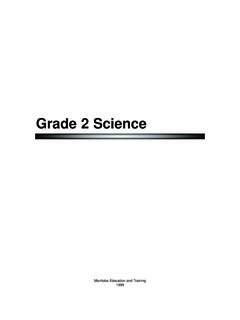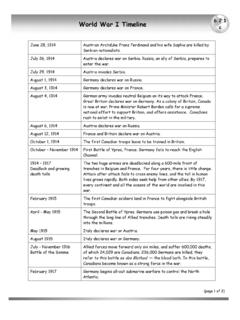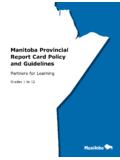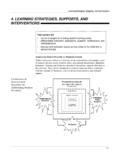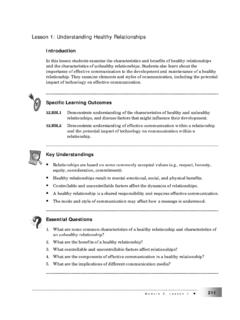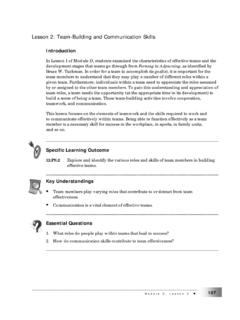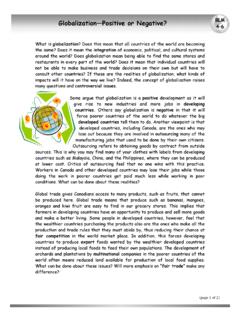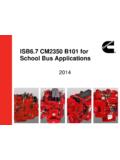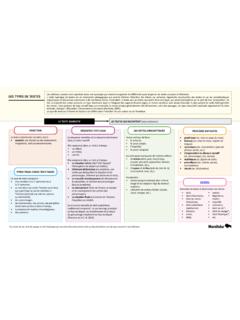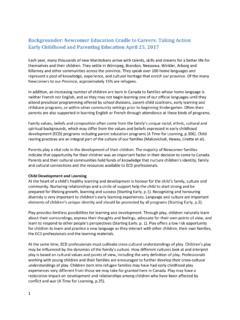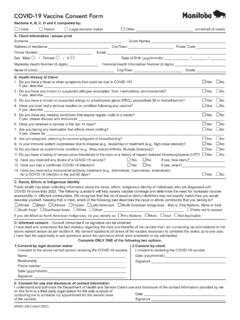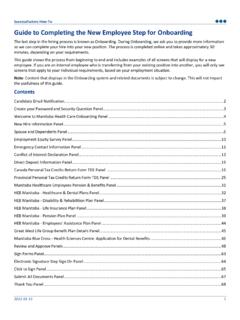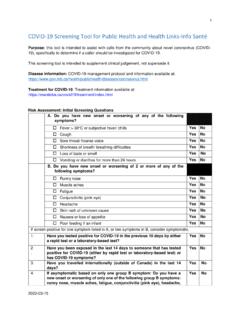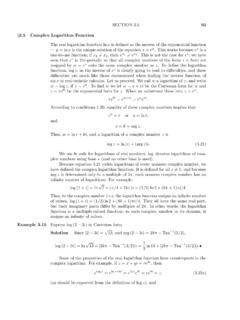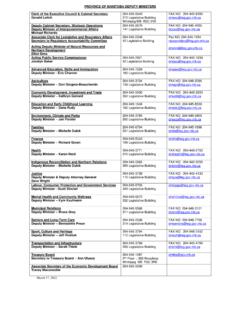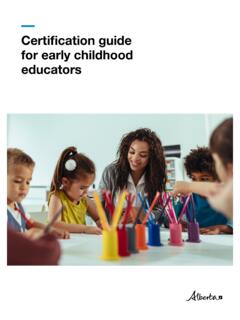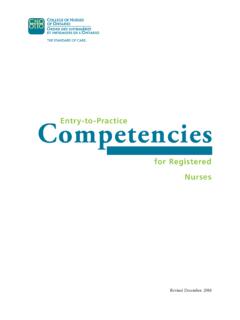Transcription of Smudging Protocol and Guidelines - Province of Manitoba
1 Smudging Protocol and GuidelinesSmudging Protocol and Guidelinesfor School Divisions2019 Indigenous Inclusion DirectorateManitoba Education and TrainingSmudging Protocol and Guidelines for school divisions, 2019 ISBN: 978- 0 -7711- 6322-7 (p df )1. Native peoples Study and teaching Manitoba . 2. Indigenous peoples Study and teaching Manitoba . 3. Native peoples Manitoba Rites and ceremonies. 4. Indigenous peoples Manitoba Rites and ceremonies. 5. Smudging Religious aspects Study and teaching. 6. Smoke Religious aspects Study and teaching. I. Indigenous Inclusion Directorate. II. Manitoba . Manitoba Education and 2019, the Government of Manitoba , represented by the Minister of Education and Inclusion Directorate Winnipeg, Manitoba , CanadaDisponible en fran and ThanksSmudging Protocol and Guidelines for School Divisions was developed by Dino Altieri Lisa Aymont Hunter Robert Apetagon Karen Courchene Gerri CrillyMarti Ford Marlene Gallagher Reid Hartry Myra LarameeAmie MartinRenee McGurry Peter Parisian Dan Thomas In consultation withCouncil of School Leaders (COSL) Manitoba Association of Parent Councils (MAPC) Manitoba School Boards Association (MSBA) Manitoba Association of School Superintendents (MASS) Manitoba Teachers Society (MTS) Smudging Protocol and Guidelines for School Divisions3 Manitoba Education and Training Smudging Protocol and Guidelines for School DivisionsBackgroundIndigenous Education is a priority for Manitoba Education and Training.
2 School divisions are working diligently to help First Nation, M tis, and Inuit students succeed in all areas, and to ensure that all students have an opportunity to learn about the important role of First Nation, M tis, and Inuit peoples in the past, present, and future of divisions have taken steps to ensure their schools are inclusive and culturally responsive by integrating First Nation, M tis, and Inuit perspectives into school planning and programming in partnership with the school community. This includes welcoming all students to learn about First Nation, M tis, and Inuit is understood and acknowledged that First Nation, M tis, and Inuit peoples are diverse in their languages and cultures. However, within this diversity, there are common characteristics that can be referred to asThe Aboriginal worldview guiding principles and traditional values of Aboriginal societies. This suggests the way Aboriginal peoples see themselves in relation to the world.
3 It is a holistic process where learning takes place across different spheres of human experience including spiritual, physical, emotional and mental dimensions. Worldviews may also consider relationships and experiences of the past, present and future as interconnected. WNCP: The Common Curriculum Framework for Aboriginal Language and Culture Programs, Kindergarten to Grade 12 (2000)The Aboriginal perspective based on the distinct worldview of the Aboriginal cultures. This worldview has humans living in a universe made by the Creator and needing to live in harmony with nature, one another, and with oneself. Each Aboriginal culture expressed this worldview in a different way and with different practices, stories, and cultural : The Common Curriculum Framework for Aboriginal Language and Culture Programs, Kindergarten to Grade 12 (2000)Many First Nations share the concept of mino-pimatisiwin, which means good life in both Cree and Ojibwe.
4 Implicit in this is the understanding that all of life is a ceremony; that the sacred and the secular are parts of the whole; that people are whole beings (body, mind, spirit, emotion); and that mino-pimatisiwin is achieved by taking care of all aspects of one s self. School divisions are working to share this perspective with their staff, students, and community to foster an atmosphere of respect, understanding, and inclusivity. Many divisions offer learning experiences about First Nation, M tis, and Inuit cultures. One of the most commonly shared experiences is the First Nation tradition of Smudging . Smudging Protocol and Guidelines for School Divisions4 What is Smudging ? Smudging is a tradition, common to many First Nations, which involves the burning of one or more medicines gathered from the earth. The four sacred medicines used in First Nations ceremonies are tobacco, sage, cedar, and sweetgrass.
5 The most common medicines used in a smudge are sweetgrass, sage, and cedar. Smudging has been passed down from generation to generation. There are many ways to perform a smudge and different variations exist. Historically, M tis and Inuit people did not smudge; however, today many M tis and Inuit people have incorporated Smudging into their community grandmother presented the following as the steps and rationale for this cleansing process we call smudge to Niji Mahkwa School in Winnipeg: We smudge to clear the air around us. We smudge to clean our minds so that we will have good thoughts of others. We smudge our eyes so that we will only see good things in others. We smudge our ears so that we will only listen to good things about others. We smudge our mouths so that we will only speak well of others. We smudge our whole being so that we will portray only the good part of our self through our allows people to stop, slow down, and become mindful and centred.
6 This allows people to remember, connect, and be grounded in the event, task, or purpose at hand. Smudging also allows people to let go of negative feelings and thoughts. Letting go of things that inhibit a person from being balanced and focused comes from the feeling of being calm and safe while Smudging . The forms of Smudging will vary from nation to nation but are considered by all to be a way of cleansing oneself. Smudging is part of the way things are done and is part of living a good life. Smudging is always voluntary. People should never be forced or pressured to smudge. It is completely acceptable for a person to indicate that they do not want to smudge. That person may choose to stay in the room and refrain from Smudging or leave the room during the smudge. Respect for all is the guiding principle in any Indigenous tradition. Smudging Protocol and Guidelines for School Divisions5 How Do We Smudge?
7 The act of clearing the air, mind, spirit, and emotions may be accomplished in a variety of ways but, according to First Nations practice, a smudge is led by a person who has an understanding of what a smudge is and why it is done. That person may be an Elder or a cultural teacher who has been invited into the school; it can be a staff person who is knowledgeable about the tradition of Smudging ; it can be a parent/guardian; or it can be a student. The medicine is placed in a smudge container. The container may be a shell; a ceramic or stone bowl; or a copper, brass, or cast iron pan. The medicine is lit with a match. Once the medicine is lit, the smoke may be pushed forward with a feather or a fan. The person who lights the smudge is first. The commonly used medicine in schools is sage. A smudge ball is created mainly from the leaf of the plant, which is rolled into a ball for burning. It is important to understand that this particular medicine can create a significant billow of smoke, which emerges from the smudge ball.
8 It is not necessary to create enough smoke to fill the entire space where a group is Smudging . Only a small stream of smoke for the person who is Smudging is required. Therefore, it is important for the helpers who create the smudge ball to keep it relatively we smudge, we first cleanse our hands with the smoke as if we were washing our hands. We then draw the smoke over our heads, eyes, ears, mouths, and our bodies. These actions remind us to think good thoughts, see good actions, hear good sounds, speak good words, and show the good of who we are. Once the smudge is over, the smudge ball is allowed to burn out naturally while the person leading the smudge watches, paying attention until it is completely out. Some people choose to bury the ashes or smudge stick ends. Other people prefer to wash the ashes away with water. It is best to check with your local Elders and knowledge keepers about their specific protocols for the ashes after a Does Smudging Look Like in a School Environment?
9 Many schools are making the tradition of Smudging a part of their practice during particular events or as part of the school for Smudging1. When introducing the tradition of Smudging , include an Elder or traditional teacher who can explain Smudging , the medicines, the teachings, and the protocols. 2. Communicate with parents/guardians, staff, and students about what Smudging is, why people smudge, and when and where Smudging will take place. Continue to educate and inform throughout the school year. Embrace and encourage dialogue within the school Protocol and Guidelines for School Divisions63. Decisions need to be made regarding when and where Smudging will be allowed. Posting signs to indicate that Smudging occurs at the school may be helpful in letting the community know that it happens as part of the school function. Smudging may be part of a learning experience in a classroom, part of a course, part of an event, or part of the regular school day.
10 It may be done in a classroom, in a gym, or outdoors, depending on the guidance from the person who is leading the smudge. The most important thing is that a smudge is done with respect of those who choose not to be involved, as well as those who choose to be involved. The school community should remember that, at one time, First Nations cultural traditions were illegal and Smudging was a practice that had to be done in secret. Those who choose to smudge need to feel welcome and respected in learning environments. Practices such as Smudging are always voluntary and people are never forced or pressured to smudge. It is completely acceptable for a person to indicate that they do not want to smudge. That person may choose to refrain from participating, and either stay in the room or leave the room during a smudge. Some schools and community organizations have posted signage in their facilities such as This is a Smudging environment and Smudging occurs regularly in this facility.
